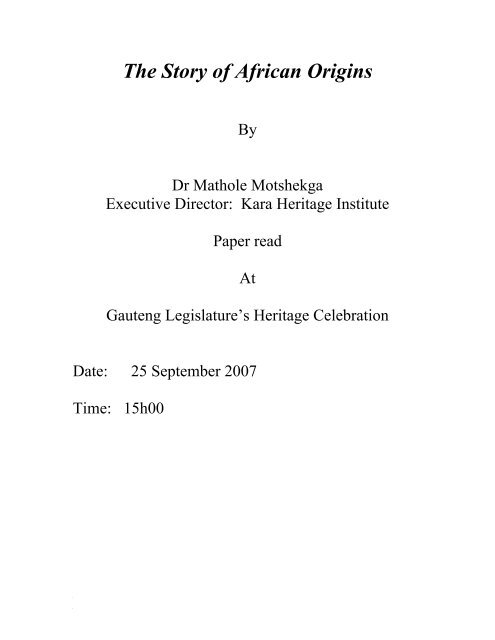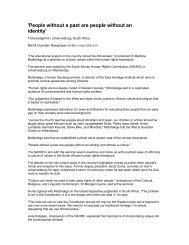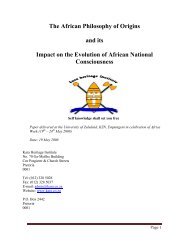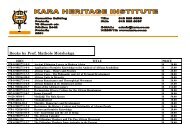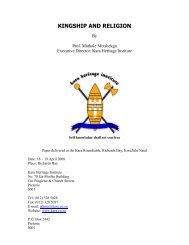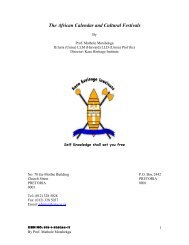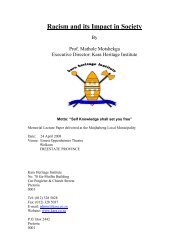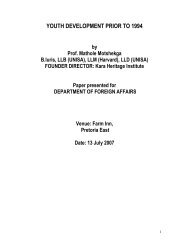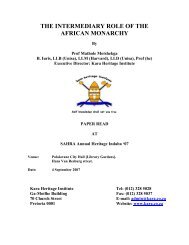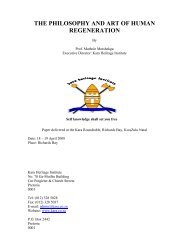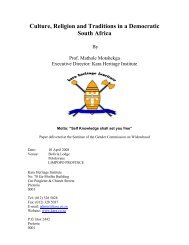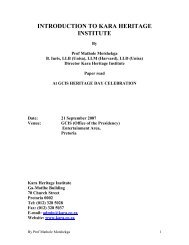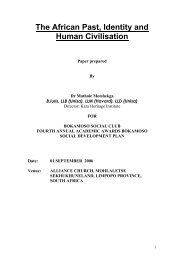Story of African Origin - kara.co.za
Story of African Origin - kara.co.za
Story of African Origin - kara.co.za
Create successful ePaper yourself
Turn your PDF publications into a flip-book with our unique Google optimized e-Paper software.
The <strong>Story</strong> <strong>of</strong> <strong>African</strong> <strong>Origin</strong>s<br />
By<br />
Dr Mathole Motshekga<br />
Executive Director: Kara Heritage Institute<br />
Paper read<br />
At<br />
Gauteng Legislature’s Heritage Celebration<br />
Date: 25 September 2007<br />
Time: 15h00<br />
By Dr Mathole Motshekga<br />
Executive Director: Kara Heritage Institute<br />
1
Background<br />
I am Molozwi-Mokhalaka also know as Molobedu.<br />
The Balovedu (also known as Balozwi) and Bavenda are an <strong>of</strong>fshoot <strong>of</strong> Barozwi Bambire<br />
who founded the Maphungubwe and great Zimbabwe Civilisations. The name Balobedu<br />
mean: the Recipients <strong>of</strong> Tributes whites Balozwi means: sacred scientists who can make<br />
rain and <strong>co</strong>ntrol the forces <strong>of</strong> nature.<br />
The BaRowzi Bambire are an <strong>of</strong>fshoot <strong>of</strong> the Makalaka/Bakhalaka people <strong>of</strong> Naphta<br />
(Now Kord<strong>of</strong>an in the Sudan, heartland <strong>of</strong> ancient Ethiopia). The Makalaka <strong>of</strong> the Sudan<br />
are also known as Bambiri. The Son <strong>of</strong> Tovera (now Thobela) called Mambiri led the<br />
BaRowzi from the Sudan to Mbire, near Lake Tanganyika in Tan<strong>za</strong>nia. From Mbire, the<br />
BaRowzi migrated to the Limpopo Valley where they established the Bokhalaka Empire<br />
with its Capital City <strong>of</strong> Maphungubwe which became both a spiritual and international<br />
trading centre <strong>of</strong> central Africa. The influence <strong>of</strong> the Maphungubwe Civilisation Spread<br />
from Limpopo to Gauteng and other provinces <strong>of</strong> South Africa. Here, in<br />
Johannesburg/Melville the early Sotho inhabitants who brought the Maphungubwe<br />
Civilisation to the South brought and planted a rain tree called Thobela. Thus<br />
Johannesburg became the heartland <strong>of</strong> Maphungubwe Civilisation.<br />
As we celebrate our heritage and in particular the <strong>African</strong> New Year it is important for<br />
our children to know who is Thobela and what is Maphungubwe culture and religion.<br />
Who is Thobela?<br />
Every human society has a story about their origins, history and identity and aspirations<br />
for the future. Missionary education and <strong>co</strong>lonialism sought to impose the biblical story<br />
<strong>of</strong> human origins on other nations without listening to their stories. The Democratic<br />
breakthrough <strong>of</strong> 1994 has opened the Doors <strong>of</strong> Education and culture which allow<br />
<strong>African</strong> people, like other human families, to say who they are, where they <strong>co</strong>me from<br />
and where they want to go.<br />
The Democratic Breakthrough <strong>of</strong> 1994 allows <strong>African</strong> people to refuse to be used as<br />
tourist attraction objects. We must thank the Gauteng Legislature under the able<br />
leadership <strong>of</strong> Hon. Richard Mdakane for <strong>of</strong>fering us an opportunity to celebrate our<br />
diverse heritage, particular, the <strong>African</strong> New Year that dawned on the 23 September<br />
2007. A heritage <strong>co</strong>lloquium and <strong>African</strong> New Year, sponsor by Sprac Ekhuruleni and<br />
Province, were held in Katorus.<br />
The Custodians <strong>of</strong> <strong>African</strong> heritage, the Amakhosi and Izinyaka do not know or accept<br />
that humanity and <strong>African</strong>s in particular descended from the baboons <strong>of</strong> Maropeng<br />
(Sterksfontein), they regard this as an insult visited on them by archeologists and<br />
paleontologists. They want the same amount <strong>of</strong> resources given to these so-called experts<br />
By Dr Mathole Motshekga<br />
Executive Director: Kara Heritage Institute<br />
2
to be given to IKS researchers and custodians to research and document the <strong>African</strong><br />
Genesis (i.e. the true story <strong>of</strong> our origins).<br />
Under <strong>co</strong>lonialism and Apartheid we were called Baboons. The democratic breakthrough<br />
<strong>of</strong> 1994 has allowed and resourced archeologists and paleotogists to make our baboon (or<br />
subhuman) <strong>co</strong>ndition a reality. Our oral traditions and story telling is the only means we<br />
have at our disposal to defend our <strong>African</strong> identity and integrity as a part <strong>of</strong> a human, not<br />
animal kingdom.<br />
As <strong>African</strong>s we use animals as symbols to explain spiritual realities, without be<strong>co</strong>ming<br />
part <strong>of</strong> the animal kingdom. A definition <strong>of</strong> and origins <strong>of</strong> the Thobela dynasty will assist<br />
us to restore <strong>African</strong> Dignity, Identity and Cultural integrity.<br />
The Thobela dynasty is rooted in the <strong>African</strong> story <strong>of</strong> <strong>Origin</strong>s, Culture and Religion. In<br />
this presentation we shall therefore begin with an exposition <strong>of</strong> the <strong>African</strong> Genesis, that<br />
is, story <strong>of</strong> <strong>African</strong> <strong>Origin</strong>s.<br />
<strong>African</strong> Genesis<br />
At noon <strong>of</strong> the 23 September 2007 the Sun appeared below the body <strong>of</strong> the Zodiacal sign<br />
<strong>of</strong> Lion ( Tau, Simba or Kapha). When the sun is in this position it is called the celestial<br />
king (Tau, Simba or Kapha). In popular languages it is called:<br />
• Tafari<br />
• Tovera<br />
• T<strong>of</strong>era<br />
• Thobela<br />
• Tautona<br />
• Simba<br />
The Sun (Faro or Thobela) is the celestial King who is represented by human kings on<br />
earth. Thus earthly kingdoms are reflections <strong>of</strong> a celestial kingdom. This <strong>co</strong>nfirms that<br />
human families emanated from and reflect the celestial family.<br />
<strong>African</strong> religion is generally regarded as a Sun-centred pagan or heathen religion.<br />
The Subversion <strong>of</strong> <strong>African</strong> culture and religion by missionaries and <strong>co</strong>lonial education<br />
created the perception that <strong>African</strong> people worship the celestial bodies, especially the Sun<br />
(Ra) and the moon (ma/maia) or the union (mara/maria) <strong>of</strong> the two. The <strong>co</strong>ncept<br />
(mara/maria) has the following variants:<br />
• Mari<br />
• Mwari<br />
• Mwalinkulukulu<br />
• Muari<br />
• Muali<br />
By Dr Mathole Motshekga<br />
Executive Director: Kara Heritage Institute<br />
3
• Mohale<br />
• Mogale<br />
• Nwari<br />
• Nwali<br />
The name Mara or Mohale refers not only to the union (mara/maria) <strong>of</strong> the moon<br />
(ma/maia) and the sun (Ra) but also <strong>of</strong> the universal mother principle which is<br />
symbolised by a spiral, ten <strong>co</strong>ncentric circles or a python biting its tail.<br />
The <strong>African</strong> heritage and, in particular, the New Year on the 23 September explains the<br />
evolution <strong>of</strong> human life and its relationship with the spiritual world.<br />
<strong>African</strong>s <strong>co</strong>nceive God as an Unknown and Unknownable First Cause or self-begotten<br />
principle that manifested itself as the Divine Light (Kara/Gara). This light is a spiritual<br />
trinity made out <strong>of</strong> mind/spirit (ka/m), thought/soul (ba/u) and word/reason (chat/ndu), in<br />
short kabachat or Mundu. The Divine Light or Spiritual trinity (kabachat/mundu)<br />
manifests itself as an enormous star surrounded by seven smaller stars.<br />
The central star (Saba) or sun (Kara) are also called respectively as the Cow (Saba) and<br />
Bull (Kara or Tara) <strong>of</strong> heaven. The Seven stars are called the Pleiades or Circumpolar<br />
(Khelemela/Izilimela) stars. These stars are also called the seven <strong>co</strong>ws <strong>of</strong> Heaven or the<br />
Seven Sisters. The <strong>African</strong> Summer (September to December) is named after the<br />
Pleiades or circumpolar stars. The central Sun (Kara) represents the God <strong>of</strong> Light<br />
Aba<strong>kara</strong> or Abaraka (Greek Abraxas), popularly known as Ramasedi, and its seven<br />
messengers called Bakare (or Bakarekare) Bakhale or Bakhalekhale i.e. the Ancient<br />
Ones.<br />
The Dawn <strong>of</strong> the <strong>African</strong> New Year, symbolised by the central Sun (Kara) and Seven<br />
Pleiades (Bakare) stars, represents the messengers <strong>of</strong> the God <strong>of</strong> Light. The Bull (Central<br />
Sun) and seven <strong>co</strong>ws (Pleiades Stars) <strong>of</strong> heaven are symbolised by the Wheel <strong>of</strong> Light.<br />
This light is symbolised by the tau cross holding together the four quarters <strong>of</strong> the earth<br />
represented by four cardinal lines.<br />
The Seven Pleiades or circumpolar (Bakare) stars are popularly known as:<br />
• Khelemela (Khilobedu)<br />
• Izilimela (Nguni)<br />
• Selemela (Sotho)<br />
• Tshilimela (Venda)<br />
• Shirilemela (Tsonga)<br />
The <strong>African</strong> summer is therefore called<br />
• Khelemo<br />
• Selemo<br />
• Isilimo<br />
By Dr Mathole Motshekga<br />
Executive Director: Kara Heritage Institute<br />
4
• Shiremo<br />
• Tshilmo<br />
The <strong>African</strong> New Year is celebrated in summer (khemo) and in particular 23 September.<br />
The appearance <strong>of</strong> the Wheel <strong>of</strong> light (Bull and Seven Cows <strong>of</strong> Heaven) on the 23<br />
September is followed by the predawn appearance <strong>of</strong> the Southern Stars, namely, the<br />
three stars <strong>of</strong> the Orion (Urhana) belt which symbolise the spiritual father (Mena/Usara),<br />
mother (Musasi) and child (Kara or Gara). The three stars appear within a square formed<br />
by four Southern Stars symbolised by giraffes (Dithutla).<br />
The appearance <strong>of</strong> the three stars <strong>of</strong> the Orion belt, <strong>co</strong>nceived as the father principle, is<br />
followed by the stars Sirius A (Kore or Sabanyadya) and B (Ra Harakhte or IAO or JAH<br />
Aba<strong>kara</strong> or Abaraka (Greek Abraxas). Sirius A and B represent the universal mother<br />
(Black Madonna) and child. The child (Ra) Harakhte or Aba<strong>kara</strong>) manifests itself as the<br />
Sun (Ra) on the 23 September.<br />
On the 23 August the Sun (Ra) appears between the paws <strong>of</strong> the celestial lion (Tau or<br />
Simba) in <strong>co</strong>njunction with the star regulus (i.e. prince <strong>of</strong> light). A month later (23<br />
September) the sun appears below the body <strong>of</strong> this lion (Simba or Tau). The Sun or<br />
celestial lion (Simba or Tau) represent the celestial king <strong>of</strong> kings (Thobela), also known<br />
as Tautona, Ingonyama, or Ingwenyama. The Distinctive features <strong>of</strong> this king <strong>of</strong> kings<br />
are (1) the leopard skin and seven solar rays represented by chevron mounted on a<br />
headdress. <strong>African</strong> divine or sacred kings (Fura or Faro) are earthly representatives <strong>of</strong><br />
the celestial king <strong>of</strong> kings.<br />
The Sun is the physical manifestation <strong>of</strong> the lion (Harakhte or Aba<strong>kara</strong>) king or bull <strong>of</strong><br />
Heaven at the centre <strong>of</strong> the Universe. This lion king or Bull resides at the centre <strong>of</strong> the<br />
universe that is expounded in the Zodiac <strong>of</strong> Maphungubwe.<br />
By Dr Mathole Motshekga<br />
Executive Director: Kara Heritage Institute<br />
5
The Structure <strong>of</strong> the Universe<br />
<strong>African</strong> people view the celestial bodies as the means by which the God <strong>of</strong> Light (Kara),<br />
also known as (Hamptah or Nyambe) administers the affairs <strong>of</strong> the world. Thus<br />
knowledge <strong>of</strong> the structure and operations <strong>of</strong> celestial bodies is the basis <strong>of</strong> the <strong>African</strong><br />
heritage and knowledge systems.<br />
The structure <strong>of</strong> the universe is depicted in the Zodiac <strong>of</strong> Maphungubwe and related<br />
Zodiacs <strong>of</strong> Matendere, Great Zimbabwe, Dendera and Meroe. The Maphungubwe<br />
Zodiac is inscribed on a circular wooden platter in the centre <strong>of</strong> the Zodiac there is a<br />
turtle (Haramanuba) or cro<strong>co</strong>dile (Nyambe) symbolising the Word <strong>of</strong> the Divine Light<br />
(IAO or JAH Aba<strong>kara</strong>) that is called God or the Most High (Modimo or Dzimu).<br />
There are two pairs <strong>of</strong> Slabs surrounding the turtle or cro<strong>co</strong>dile. The Slabs in each pair<br />
are facing in opposite directions. These four Slabs symbolise the four quarters <strong>of</strong> the<br />
universe or four rudders <strong>of</strong> Heaven represented by the four cardinal points. They also<br />
represent the four cardinal points <strong>of</strong> water, fire, earth, and air while the turtle or cro<strong>co</strong>dile<br />
represents the fifth element or quintessence.<br />
The turtle or cro<strong>co</strong>dile is surrounded by Six planets (Kabiri). The Sun and the Six planets<br />
make out the seven celestial spheres which lead into the eighth sphere. The seven outer<br />
planets and their governing spirits are called the Kabiri or sons <strong>of</strong> Tapa (or Pata),<br />
popularly known as Ptah. The <strong>co</strong>untries Egypt (Hakaptah) and Ethiopia (At(h)pe), were<br />
named after God Ptah, the Master Architect <strong>of</strong> the Universe.<br />
The eighth sphere, called the Ogdoad (Chamnu/Khnum), is represented by the twelve<br />
fixed stars called the Zodiac. These twelve divisions <strong>of</strong> heaven are governed by twelve<br />
Gods called Bantare (or Bantarentare) or Bondoro or Bondorondoro i.e. the most ancient<br />
ones). These Gods are also aspects <strong>of</strong> the God that is called Father <strong>of</strong> Lights (Ramasedi)<br />
or The Everlasting (IAO or JAH) Father (Aba) <strong>of</strong> the Divine Light (Kara or Raka). The<br />
eighth sphere or Zodiac is divided into 365 heavens governed by IAO (or JAH) Aba<strong>kara</strong><br />
or Abaraka (Greek Abraxas).<br />
The eighth sphere leads into the Ennead (i.e. a Trinity <strong>of</strong> trinities) which leads into the<br />
One <strong>of</strong> Good that is called the Unknown and Unknowable God Ptah. The Ennead (i.e.<br />
nine aspects <strong>of</strong> Ptah) are known as messengers which link up heaven and earth.<br />
The hierarchy <strong>of</strong> the Gods governing the universe <strong>co</strong>rrespond to the following celestial<br />
bodies:<br />
• Bull <strong>of</strong> Heaven<br />
• Four Rudders <strong>of</strong> Heaven<br />
• Seven Pleiades or Circumpolar stars<br />
• Seven outer planets<br />
• The Seven Pleiades stars and seven outer planets make out the ladder <strong>of</strong><br />
heaven or chain <strong>of</strong> being that link heaven and earth.<br />
By Dr Mathole Motshekga<br />
Executive Director: Kara Heritage Institute<br />
6
• The twelve signs <strong>of</strong> the Zodiac or houses <strong>of</strong> the sun which <strong>co</strong>rrespond with the<br />
twelve hours <strong>of</strong> the Day and twelve hours <strong>of</strong> the day.<br />
The Ladder <strong>of</strong> Heaven is the path <strong>of</strong> the light that enlightens the four phases <strong>of</strong> the moon.<br />
The descent and ascent <strong>of</strong> the Solar light for twenty-eight (14 + 14) days make out 28<br />
lunar days. When the two dark days <strong>of</strong> the moon are added to the 28 they bring the total<br />
number <strong>of</strong> a Lunar Year to 30 days. The moon (ma/maia) spend 30 days <strong>of</strong> 24 hours<br />
each in each <strong>of</strong> the 12 signs <strong>of</strong> the Zodiac, bring the total number <strong>of</strong> a lunar month to 360.<br />
Upon the <strong>co</strong>mpletion <strong>of</strong> an annual Lunar Cycle the moon (ma/maia) and the sun (Ra) are<br />
united. The union (mara/maia) <strong>of</strong> the moon (ma/maia) and the Sun (Ra) reproduces the<br />
five elements <strong>of</strong> spirit, water, fire, earth and air on each successive day, bringing the total<br />
number <strong>of</strong> days <strong>of</strong> a lunar year to 365.<br />
The Image and Identity <strong>of</strong> the Human Personal<br />
The appearance <strong>of</strong> the Bull <strong>of</strong> and seven <strong>co</strong>ws <strong>of</strong> heaven is followed by the seven<br />
Southern stars <strong>co</strong>nsisting <strong>of</strong> the three stars <strong>of</strong> the Orion belt within a square formed by the<br />
four Southern stars symbolized by giraffes. These stars are followed by the predawn<br />
appearance <strong>of</strong> the stars Sirius A (Saba, Kore or Mari) and BC Harakhte). After the<br />
appearance <strong>of</strong> these stars the sun (Ra) rises below the body <strong>of</strong> the celestial lion (Simba or<br />
Tau). On the 23 September, marking the beginning <strong>of</strong> the <strong>African</strong> New Year.<br />
The Constitution <strong>of</strong> the sun<br />
The Solar (P or Ra) principle manifests itself as the Ancient Pillar (Zindj-ka-Fura)<br />
<strong>co</strong>nsisting <strong>of</strong> five cubes mounted on a rod.<br />
=<br />
By Dr Mathole Motshekga<br />
Executive Director: Kara Heritage Institute<br />
= kabachat/mundu<br />
(ether/quintessence)<br />
= manu (water)<br />
= Aakhut (fire)<br />
=Rastau (earth)<br />
=Amentu (air)<br />
7
This means that the sun (Pa(a) or Ra) is made out <strong>of</strong> ether (or quintessence), water, fire,<br />
earth and air. These are the five <strong>co</strong>nstitutive elements <strong>of</strong> being.<br />
The Ancient Pillar (P or Ra) also manifests itself as a Pyramaat (Pyramid) or an<br />
equilateral triangle mounted on a square. In these two figures the fifth element<br />
(Kabachat/Mundu) is made out <strong>of</strong> three aspects:<br />
Ka + ba + chat = Kabachat<br />
M + u + ndu = Mundu<br />
The fifth (Kabachat/Mundu) element is symbolised by and encircled equilateral triangle<br />
mounted on a square<br />
Manu (water)<br />
Aakhut (fire)<br />
Rastau (earth)<br />
Amenti (air)<br />
Cha/ndu (light body)<br />
Ka/m ba/u ba/a<br />
(Mind/Spirit) (Thought/soul)<br />
The sun (Ra), is there a Union <strong>of</strong> the spirit (i.e. fifth element) and matter (i.e. the four<br />
elements <strong>of</strong> water, fire, earth, and air).<br />
The sun (Ra) split into thought (ma) and mind (Ra), which one in two, and manifest as<br />
the Divine Light. The light partially turned into a darkness which produced a watery<br />
abyss. Then a Voice or Word issued from this light, saying that the Voice or Word is the<br />
son <strong>of</strong> God. This son was the son <strong>of</strong> God who is symbolised by the planet mercury<br />
(Kara).<br />
The sun (Ra), planets Venus (mara) and Mercury (Kara) form a trinity symbolised by the<br />
Solar K<strong>kara</strong>) monogram.<br />
By Dr Mathole Motshekga<br />
Executive Director: Kara Heritage Institute<br />
8
Represent the Nothingness from which<br />
the first principle emanated<br />
Represents the Sun (Ra) i.e. the mind<br />
Represents the planet Venus (Mara) the thought<br />
Represents the planet mercury (Kara) or Word<br />
Thus the Solar symbolise a spiritual trinity. Universal (or <strong>co</strong>smic) spirit called<br />
IAO (or JAH), also known as Akhet or Akhte (Greek Eichton or Ichtus). The Piscean<br />
God Ichtus and the Solar (Kara) found expression in the divine symbols (Akhte)<br />
and (Kara, or Hara or Chara). Thus the God is also<br />
known as Harakhte (Hara + Akhte).<br />
The God IAO (or JAH) Aba<strong>kara</strong> or Abaraka (Greek Abraxas is the same as Ra Harakhte<br />
or Xpakhte (Greek Xpictoc), pronounced Christos (i.e. the light (chr) and life (istos) <strong>of</strong><br />
the sun (Ra). This means that the Christ (Harakhte) is not a human God but the rising sun<br />
and the light and life that issue from it.<br />
The Akhet, like the sun is symbolised by an encircled point Θ mounted on a lunar<br />
crescent (u) to symbolise the Union (mara/maria) between the female (ma) and male (ra)<br />
principles. This Union (mara/maria) reproduces the Word Umbe (i.e. the Word) or the<br />
Word (mbe) <strong>of</strong> the Divine Light (Kara or Raka).<br />
The Word <strong>of</strong> the Divine Light (Mbe<strong>kara</strong> or Mberaka) is also known as Mbire or Mbiri.<br />
These names <strong>co</strong>nsists <strong>of</strong><br />
• mbi meaning the Word.<br />
By Dr Mathole Motshekga<br />
Executive Director: Kara Heritage Institute<br />
9
• Re/ri meaning the Sun<br />
Thus the names mbire and mbiri mean: the Word <strong>of</strong> the Sun. The baboon (Soko or<br />
Shoko) symbolises the Word <strong>of</strong> the Sun (Mbire). Thus Shoko Mbire or Mberaka.<br />
The baboon (Soko Mbire) symbolises the creator <strong>of</strong> earth. This baboon carries a Solar<br />
disc mounted on a Lunar Crescent. This baboon is sitted on a cube (kaba or Tamara)<br />
symbolizing the earth<br />
The Baboon Symbol<br />
The Cube (Kaba or Tamara) symbolises the mother earth which emanated from the Word<br />
<strong>of</strong> the Divine Light (Mbe<strong>kara</strong>) or Word <strong>of</strong> the sun (Mbire) symbolised by the baboon<br />
(Soko or Shoko). The Cube also symbolise the <strong>co</strong>nstitutive elements <strong>of</strong> the human<br />
personality.<br />
The Constitution <strong>of</strong> the Human Personality<br />
The human personality is made out <strong>of</strong> spirit and matter. The spirit <strong>co</strong>nsists <strong>of</strong> mind<br />
(m/ka), soul (ba/u), and body (chat/ndu) while matter <strong>co</strong>nsists <strong>of</strong> the five elements <strong>of</strong><br />
water (manu), fire (Aakhut), earth (Rastau), and air (Amenti). This elements are depicted<br />
by the encircled equilateral triangle mounted on a square. The <strong>African</strong> Sage, ThauThau-<br />
Harama (Greek Thoth-Hermes), says that the (hu)man is both mortal and immortal. s/he<br />
is immortal by virtue <strong>of</strong> its spiritual aspect <strong>co</strong>nsisting <strong>of</strong> mind (ka/m), soul (ba/u), and<br />
body (chat/ndu) and mortal by virtue <strong>of</strong> the physical body which is perishable.<br />
The moral degeneration facing <strong>African</strong> <strong>co</strong>mmunities today stems from the failure to<br />
acknowledge the existence <strong>of</strong> the spiritual aspect <strong>of</strong> the human personality and to<br />
minister to its needs. The worth and dignity <strong>of</strong> the human personality and its inherent<br />
By Dr Mathole Motshekga<br />
Executive Director: Kara Heritage Institute<br />
10
and inalienable human rights resides in the spiritual aspect <strong>of</strong> the human personality. The<br />
universality <strong>of</strong> the spiritual aspect <strong>of</strong> the human personality appears in the <strong>co</strong>mparative<br />
table below.<br />
Comparative Table<br />
ka ba chat Kabachat<br />
m u ndu Mundu<br />
m u ntu Muntu<br />
m u nthu Munthu<br />
m u thu Muthu<br />
m u tu Mtu<br />
m o tho Motho<br />
m u nhu Munhu<br />
mind thought word Higher Self<br />
spirit soul reason Higher Self<br />
mind soul body Higher Self<br />
The intrinsic quality <strong>of</strong> the Higher Self is called Ubuntu, Vundu or Botho. i.e. the<br />
humanity <strong>of</strong> all human beings regardless <strong>of</strong> <strong>co</strong>lor, race, or creed.<br />
By Dr Mathole Motshekga<br />
Executive Director: Kara Heritage Institute<br />
11


